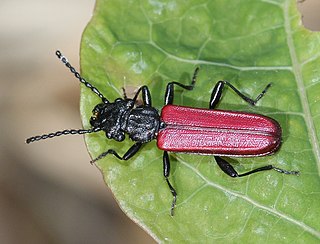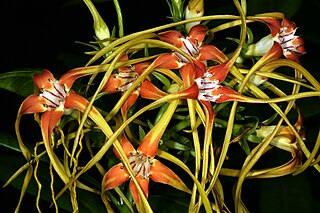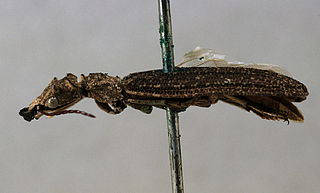
The true parrots are about 350 species of colorful flighted hook-billed, mostly herbivorous birds forming the superfamily Psittacoidea, one of the three superfamilies in the biological order Psittaciformes (parrots). True parrots are widespread, with species in Mexico, Central and South America, sub-Saharan Africa, India, Southeast Asia, Australia, and eastwards across the Pacific Ocean as far as Polynesia. The true parrots include many of the familiar parrots including macaws, conures, lorikeets, eclectus, Amazon parrots, grey parrot, and budgerigar.

The Cucujidae, "flat bark beetles," are a family of distinctively flat beetles found worldwide under the bark of dead trees. The family has received considerable taxonomic attention in recent years and now consists of 59 species distributed in four genera.

Strophanthus is a genus of flowering plants in the family Apocynaceae, first described as a genus in 1802. It is native primarily to tropical Africa, extending to South Africa, with a few species in Asia from southern India to New Guinea and southern China. The genus name is a compound of the Greek words στροφος (strophos) "twisted" and ανθοσ (anthos) "flower", in reference to the corolla lobes which, in some species - notably S. petersianus - resemble long twisted ribbons or threads and can reach a length of 30–35 cm. This trait, in addition to colouring involving combinations of bright pinks, purples and oranges, combine to make the flowers among the most ornamental in the plant kingdom.

Belidae is a family of weevils, called belids or primitive weevils because they have straight antennae, unlike the "true weevils" or Curculionidae which have elbowed antennae. They are sometimes known as "cycad weevils", but this properly refers to a few species from the genera Parallocorynus and Rhopalotria.

The Eumolpinae are a subfamily of the leaf beetles, or Chrysomelidae. It is one of the largest subfamilies of leaf beetles, including more than 500 genera and 7000 species. They are oval, and convex in form, and measure up to 10 mm in size. Typical coloration for this subfamily of beetles ranges from bright yellow to dark red. Many species are iridescent or brilliantly metallic blue or green in appearance.

Melolonthinae is a subfamily of the scarab beetles. It is a very diverse group; distributed over most of the world, it contains many familiar species. Some authors include the scarab subfamilies Euchirinae and Pachypodinae as tribes in the Melolonthinae.

The Luciolinae are among the largest subfamilies of fireflies (Lampyridae). They seem to be all "flashing" fireflies. They are a diverse lineage, spreading throughout the warm parts of Eurasia into temperate Europe and East Asia and south to the Australian region.

The Ommatidae are a family of beetles in the suborder Archostemata. The Ommatidae are considered the extant beetle family that has most ancestral characteristics. Extant species of this group only occur in Australia and South America, but the geographical distribution was much wider during the Mesozoic spanning across modern day Europe, Siberia, Myanmar, and China. Discovery of Upper Jurassic Chinese and Upper Cretaceous Burmese amber fossils suggest that they were widespread on Pangea. So far, 25 extinct genera containing over 100 species of these beetles have been described. Three extant genera have been assigned to this family: Omma,Tetraphalerus and Beutelius. The family is considered to be a subfamily of Cupedidae by some authors, but have been found to be more closely related to Micromalthidae by DNA analysis.

Laemophloeidae, "lined flat bark beetles," is a family in the superfamily Cucujoidea characterized by predominantly dorso-ventrally compressed bodies, head and pronotal discs bordered by ridges or grooves, and inverted male genitalia. Size range of adults is 1–5 mm (0.04–0.2 in) in length. Currently, it contains 40 genera and about 450 species, and is represented on all continents except Antarctica; species richness is greatest in the tropics.

Silvanidae, "silvan flat bark beetles", is a family of beetles in the superfamily Cucujoidea, consisting of 58 described genera and about 500 described species. The family is represented on all continents except Antarctica, and is most diverse at both the generic and species levels in the Old World tropics.

Pyrgomorphidae is a family of grasshoppers in the order Orthoptera; it is the only family in the superfamily Pyrgomorphoidea, with a pan-tropical distribution. Their name is probably derived from pyrgos meaning "tower": a reference to the form (morph) of the head in the type genus Pyrgomorpha and other genera.

Hexarthrius parryi, the fighting giant stag beetle, is a species of large stag beetles. It belongs to the genus Hexarthrius of the tribe Lucanini. It is classified under the subfamily Lucaninae of the stag beetle family Lucanidae.

Orphinus is a genus of beetles in the family Dermestidae, the skin beetles. The genus is distributed in Africa, Asia, and the Australian region, especially in tropical areas; at least one species is cosmopolitan. There are about 88 species.

Brontopriscus is a genus of beetles in the family Silvanidae, subfamily Brontinae. The genus, comprising two species B. sinuatus and B. pleuralis, is found only in New Zealand. Members of Brontopriscus are characterized as broad, dorsally flattened beetles having very long, filiform antennae, wide elytral epipleura, fused elytra, and absence of hind wings.

Uleiota is a genus of beetles in the family Silvanidae, containing the following species:

Cryptamorpha is a widespread genus of beetles in the family Silvanidae, which has not been revised taxonomically. The best known species is Cryptamorpha desjardinsi. The most recently described species is Cryptamorpha triregia, from the Three Kings Islands, New Zealand.

Protodendrophagus is a genus of beetles in the family Silvanidae. The single described species, Protodendrophagus antipodes, is known only from several localities high in the mountains of South Island, New Zealand, where it has been found under rocks.

Coprini is a tribe of scarab beetles, in the dung beetle subfamily (Scarabaeinae). Scholtz et al. describe them as tunnellers that are shiny black, of moderate to large size and with a strongly convex shape. They also, however state that the grouping based on these characteristics has little phylogenetic validity, and the placement of several genera in this and related tribes is likely to change.

Cartwrightia is a genus of scarab found in Latin America. It was named and circumscribed in 1958 by Federico Islas Salas. As of 2017, three species are recognized: C. intertribalis, C. cartwrighti, and C. islasi. They can be found in the nests of leafcutter ants or in dung.

Bromiini is a tribe of leaf beetles in the subfamily Eumolpinae. The tribe contains approximately 120 genera, which are found worldwide. They are generally thought to be an artificial group, often with a subcylindrical prothorax without lateral ridges and covered with setae or scales.
Háva J. 2016. Macrohyliota philippinensis sp. nov. (Coleoptera: Silvanidae: Brontinae), a new species from the Philippines. ARQUIVOS ENTOMOLÓXICOS, 16: 431-434.




















